How 5 Kayakers Were Taken Hostage in Colombia by FARC Rebels
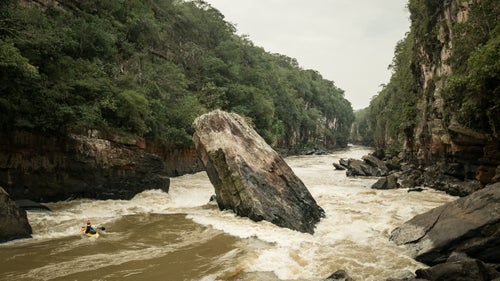
Last November, when the Colombian government struck a long-awaited peace accord with the rebel group FARC, which has occupied the country’s jungles for decades, Ben Stookesberry began planning a kayaking trip to the embattled country. He and four fellow paddlers had their sights set on the Rio Apaporis, a 700-mile river that wends through swaths of the Amazon basin, from central Colombia clear to the Brazilian border. They assumed they’d be able to negotiate passage with any armed guerillas they might encounter if they launched in the spring. They were wrong.
Stookesberry, a 38-year-old Coloradoan who has kayaked some of the world’s most remote rivers, says the Apaporis had been on his radar for about 15 years because he knew the territory was relatively unexplored. He’d paddled in Colombia on five separate occasions between 2003 and 2008, but called off any more expeditions there due to the government’s war against the FARC, which spanned 52 years and left more than 220,000 dead. “For the longest time you couldn’t get near the Apaporis,” he says.
The peace accord opened an opportunity. On March 30, the five kayakers launched their boats at the village of La Tunia, attempting to make the first descent of the Rio Apaporis over 30 days. Twenty-one days and 500 miles later, FARC rebels ended it. The photos the kayakers took along the way offer a glimpse of how it happened.
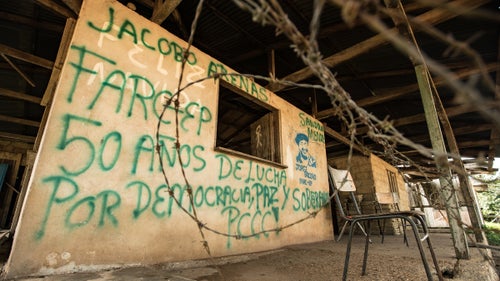
The Apaporis River, which runs southeast of the Andes mountains, is a “bit of an anomaly” in that it doesn’t pass through any major communities on its southward path to Brazil, Stookesberry says. Because the river doesn’t skirt any population centers, its banks served as prime territory for guerrillas during years of war. La Tunia, a small village 200 miles south of Bogota, was no different. FARC rebels had been active in the village and, in 2004, even shot up the local school. When the team arrived on March 30 to launch their boats, they discovered an abandoned FARC headquarters near the center of town.
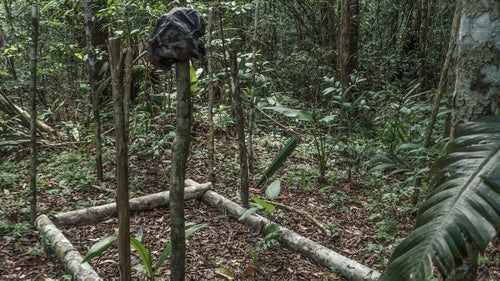
For the first nine days, the team paddled a mix of rapids and slow water on the Rio Tunia, which converges with the Rio Ajuja at the Apaporis headwaters. The Rio Tunia brought the team to the Chiribiquete Gorge, a stretch of river locals said had never been successfully navigated in a boat. On April 6, as the team scouted the area to ensure they could paddle the rapids safely, they found hieroglyphics scrawled on rock walls and the remnants of a camp likely recently vacated by FARC combatants.
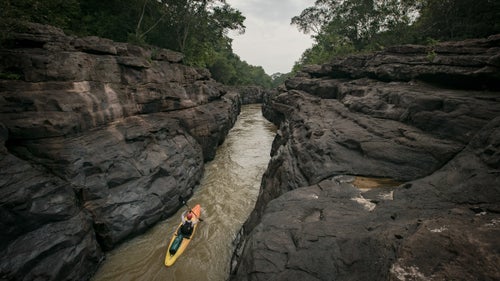
Aniol Serrasolses, an Extreme Kayak World Champion from Spain, paddles through the Chiribiquete Gorge on April 7, the eighth day of the expedition. Though the team saw traces of FARC activity along the way, they saw few people during the first 500 miles of the expedition.
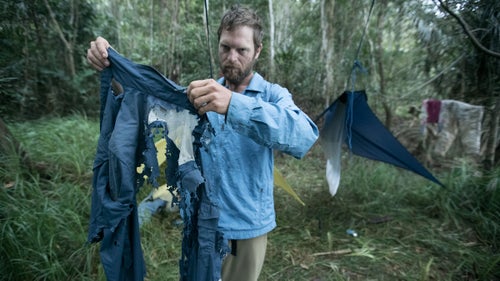
On the night of April 16, before bed, Stookesberry hung his wet paddling shirt on the tie string of his hammock. By the next morning, leafcutter ants had devoured the shirt, leaving it in rags. Colombia is considered one of the world’s most biodiverse countries, boasting dense vegetation, more than one hundred endangered species, and hordes of insects. Some scientists estimate that 30 percent of the Amazon region’s animal biomass is made up of ants alone. The team, however, was more worried about running into poisonous snakes, anacondas, and jaguars.
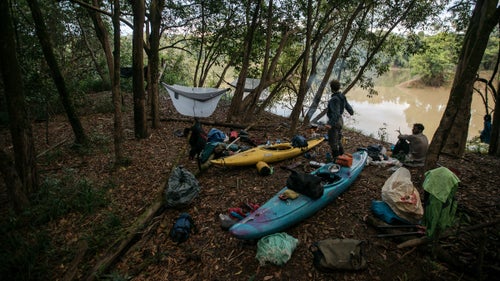
On April 11, kayaker Jules Domine stretches at the bank of the river while Aniol Serrasolses sits behind him. Also on the expedition was Chris Korbulic, a professional paddler and photographer and Stookesberry’s long-time paddling partner, and Jesse Rice, an American competitive kayaker who had recently guided in Chile.

On April 18, Jules Domine (left) speaks with a family just up river from the village of Lerida about three weeks into the trip. Shortly after this photo was taken, Domine, Serrasolses, and Korbulic paddled ahead, and were stopped by an armed group in a wooden canoe with an outboard motor. Stookesberry and Rice were informed of the situation by villagers on the shore, so they paddled to the opposite side of the quarter-mile-wide river to avoid an encounter themselves. It didn’t work. The armed group—which identified itself as a dissident FARC movement—found the remaining kayakers after a short search. But after searching and questioning each kayaker, the FARC rebels granted them passage into the village where they were free to spend the night.
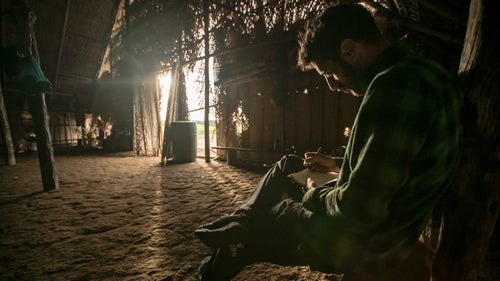
On April 19, in a hut in Buenos Aires, Aniol Serrasolses writes in his journal the morning after the team first encountered FARC rebels a few miles upstream and had been released. He had planned to catch a flight out from Buenos Aires partway through the trip to compete at a paddling event in the U.S. While he stayed behind to arrange a flight, the rest of the team resupplied with food and water in the village and paddled down to JiriJirimo Falls to spend the night. They planned to continue their trip the next day.

Jules Domine stands on a ledge overlooking JiriJirimo falls on April 19. Earlier that day, the kayakers received word from Serrasolses that the FARC rebels made contact with him again and assured him everything was okay. But the next morning, Serrasolses, who was supposed to be on a plane to the U.S., arrived at the waterfall with an armed FARC rebel. At that point, Stookesberry says, “We knew something was wrong.”

Jules Domine (left) chats with a local fisherman on April 20, minutes before a FARC guard arrived to detain the kayakers. The guard told them to gather all of their stuff and come to a FARC camp a few miles away. “We didn’t really have a choice in the matter,” Stookesberry says. “We told them we didn’t want to come with them, but if it was necessary and it was something that would end quickly, then we would happily do it.” The guard brought the kayakers to the camp on the banks of the river and told them not to use any electronics.
However, Stookesberry discretely used his Garmin InReach satellite communicator to text his friend, Taylor Robertson, as well as a local Colombian contact, who had contact with a private security company as well as government officials in Colombia and the U.S. Stookesberry told Robertson to wait at least 24 hours before contacting any government agencies, hoping that the situation would resolve itself.